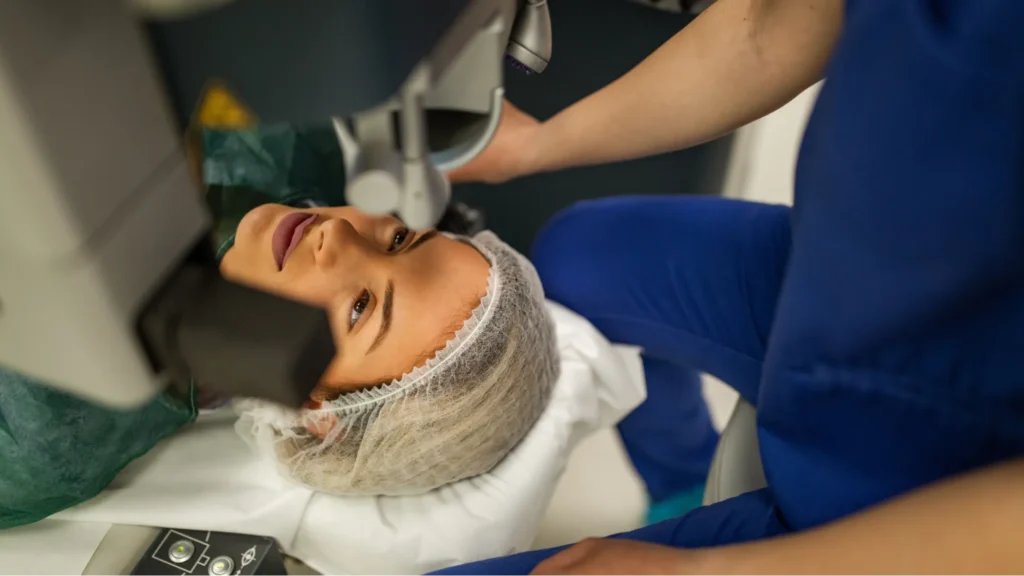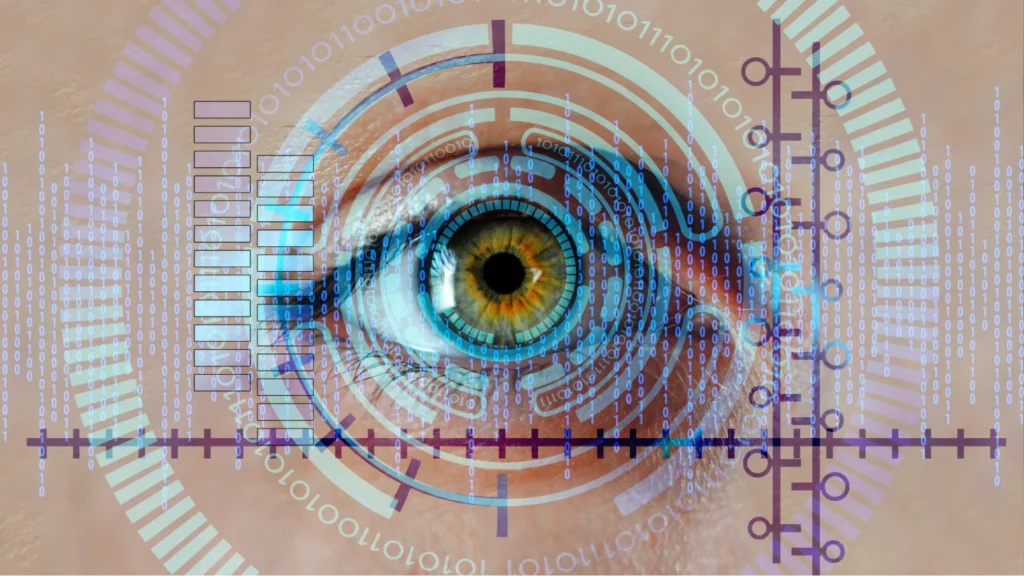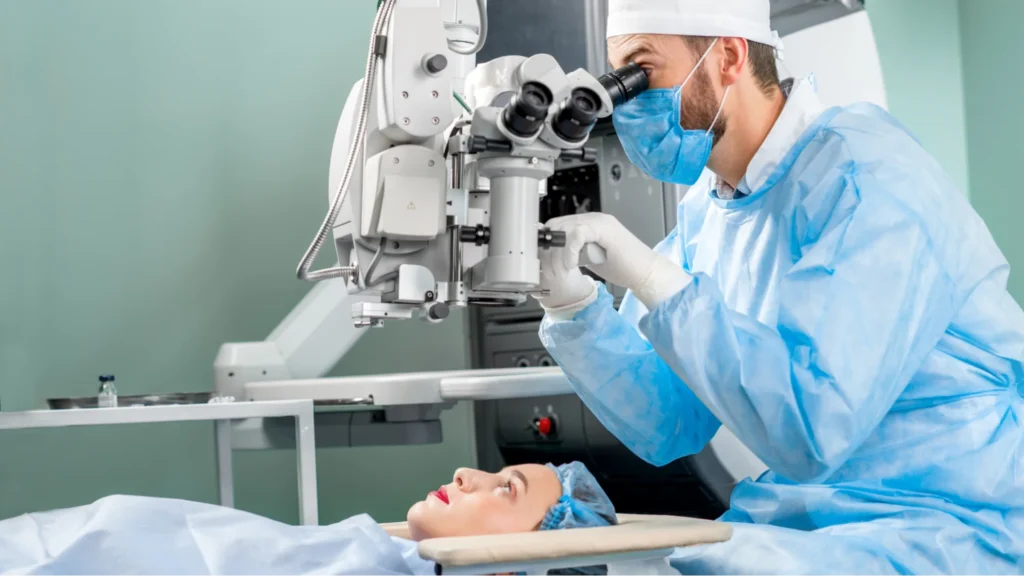If you live in Ontario and you’re over glasses fogging up in winter or contacts drying out during long screen sessions, you’re not alone. Whether it’s packing lens solution every time you travel, dealing with irritation during allergy season, or just wanting to wake up and see, laser eye surgery might feel like the freedom you’ve been craving.
But with so many new procedures and acronyms—LASIK, SMILE, Contoura, EVO ICL—it’s hard to know where to start. That’s exactly what this blog is for. We’ll walk you through the top laser eye surgery options available in 2025, break down the tech behind each one, and help you figure out what might be right for your eyes, your lifestyle, and your long-term goals.
What Is Laser Eye Surgery?
Laser eye surgery refers to a group of procedures that reshape the cornea (the clear front part of your eye) to fix how light enters your eye, giving you sharp, glasses-free vision. It’s most often used to treat:
- Myopia (near-sightedness)
- Hyperopia (far-sightedness)
- Astigmatism
- Presbyopia (age-related near-vision loss)
LASIK Surgery: Still Popular, Still Powerful
LASIK (Laser-Assisted In Situ Keratomileusis) has been reshaping eyes—and lives—since the 1990s. In a quick, outpatient procedure, a femtosecond laser carves a thin, precise flap in your cornea. The surgeon lifts this flap, then uses an excimer laser to sculpt the underlying tissue, correcting how light focuses on your retina. Once the flap is smoothed back down, your vision often clears within hours.
Why People Still Choose LASIK
- Blazing-fast recovery: Most patients return to work or school within 24–48 hours, with driving vision often restored the very next day.
- Comfort-first: The pairing of femtosecond and excimer lasers makes the procedure virtually painless—many describe only a gentle pressure sensation.
- Custom-fit precision: Options like Wavefront-guided LASIK and Contoura Vision LASIK tailor the laser to your eye’s unique curvature and higher-order aberrations, reducing glare and halos at night.
- AI-powered mapping: Cutting-edge diagnostics analyze tens of thousands of corneal data points, letting your surgeon program the laser for nano-scale accuracy.
- Versatile corrections: LASIK tackles myopia up to 12 D, hyperopia to +6 D, and astigmatism up to 6 D, so it covers most stable prescriptions.
What to Watch For
- Dry-eye flare-ups: Creating the corneal flap severs nerves that trigger tear production. Most cases resolve in weeks, but heavy screen users should plan for extra lubrication and follow‑up care.
- Flap-related risks: Though rare (<1%), flap wrinkles or dislodgement can occur if the eye is bumped during healing. Athletes in contact sports may opt for flapless options to avoid this.
- Candidacy matters: You need a stable prescription (12+ months unchanged), sufficient corneal thickness, and no active eye disease. A detailed screening—including corneal topography and thickness mapping—keeps you safe.
SMILE Eye Surgery: No Flap, Less Dryness
SMILE (Small Incision Lenticule Extraction) is a bladeless, flap-free procedure where a femtosecond laser cuts a tiny disc-shaped piece inside the cornea, which is then removed through a small incision.
Why SMILE Is Trending in 2025:
- Flapless Procedure: Unlike LASIK’s larger flap, SMILE uses a tiny 2–4 mm incision, so there’s virtually no risk of flap displacement, not to mention fewer healing restrictions for athletes or job sites where impact is possible.
- Dry‑Eye Friendly: By preserving more corneal nerves, SMILE slashes the chance of post‑op dryness. That makes it a go-to for people glued to screens, those with seasonal allergies, or anyone who’s battled itchy eyes in the past.
- Sharper Night Vision: Early-generation lasers sometimes left halos around lights. SMILE’s lenticule removal tends to induce fewer higher‑order aberrations, helping drivers and night owls enjoy crisper vision after dark.
- More Cornea Left Standing: Since tissue is cut deeper rather than removing surface layers, the anterior cornea stays stronger, ideal for those with borderline thickness who might not qualify for traditional LASIK.
- Proven Speed: Most SMILE patients see functional vision by day 2, with final clarity by one week, nearly as quick as LASIK but without the flap.
Limitations:
- Nearsighted Focus Only: Health Canada and the FDA currently approve SMILE for myopia and simple astigmatism. If you have hyperopia (farsightedness) or presbyopia, you’ll need a different procedure.
- Customization Trade‑Off: While Contoura or wavefront LASIK can tailor to tiny corneal irregularities, SMILE’s single‑laser approach offers less fine‑tuning. Most eyes do fine, but complex prescriptions or corneal asymmetries may benefit more from topography‑guided options.
PRK & TransPRK Eye Surgery: Surface Ablation Solutions

PRK (Photorefractive Keratectomy) and its modern cousin, TransPRK, reshape the cornea without creating a flap. Instead, the outer epithelial layer is removed—either manually or by laser—then an excimer laser precisely sculpts the stromal surface.
Why Consider PRK in 2025:
- No Flap, No Fuss: By avoiding a corneal flap entirely, PRK removes any risk of flap-related issues. It’s ideal for patients with thin corneas or those in contact sports and physically demanding jobs.
- Broad Eligibility: Even those with borderline corneal thickness or mild surface irregularities often qualify for PRK when LASIK or SMILE isn’t an option.
- TransPRK Breakthrough: The “no-touch” TransPRK technique lets the excimer laser peel off epithelial tissue and reshape the cornea in one seamless step. Many patients report gentler healing and less discomfort compared to traditional PRK.
What to Expect
- Longer Healing Curve: Surface ablation means the epithelium takes 4–5 days to regenerate. Expect moderate discomfort, light sensitivity, and blurry vision initially, with functional sight around day 5–7 and full clarity by 1–2 weeks.
- Bandage Lens & Drops: A temporary contact lens shields the healing surface, and a regimented drop schedule (antibiotic, anti-inflammatory, lubricants) is crucial for comfort and flap-free success.
Weighing Pros & Cons
- Pros:
- Zero risk of flap complications
- Preserves maximum corneal strength
- TransPRK offers improved comfort and faster re-epithelialization
- Cons:
- Slower, often more uncomfortable recovery
- Higher chance of transient haze without proper preventive care
- Requires days off work and a strict post-op routine
Next-Gen Tech: Beyond LASIK, SMILE, and PRK
Contoura Vision LASIK
- Uses topography-guided mapping to treat not only your prescription but also the unique imperfections in your cornea
- Offers improved contrast sensitivity and night vision
Wavefront-Guided LASIK (Wavelight)
- Tailors your treatment based on how light travels through your entire eye, not just the surface
- Great for people with large pupils or higher-order aberrations
Advanced Surface Ablation (ASA)
- A variation of PRK, ideal for patients with irregular corneas
- Takes longer to heal, but avoids the flap-related complications of LASIK
Not Technically “Laser” – But Worth Knowing
EVO ICL (Implantable Collamer Lens)
- A thin lens is implanted between your iris and natural lens, like adding a permanent contact lens inside your eye
- Doesn’t reshape the cornea, so it’s reversible
- Ideal for people with very high prescriptions or thin corneas
- UV protection built in, and no risk of dry eye
Refractive Lens Exchange (RLE)
- Common for people over 45, especially those dealing with presbyopia
- Your natural lens is swapped out for an artificial one, similar to cataract surgery
- Can’t get cataracts later in life—bonus!
Orthokeratology (Ortho-K)
- Special rigid lenses are worn overnight to gently reshape the cornea
- Non-surgical, safe for kids and adults—but results are temporary
- Popular among athletes or those not ready for surgery
What’s New in 2025?

AI-Powered Eye Mapping
Today’s lasers are smarter. AI helps build ultra-detailed eye maps so your treatment is more precise and predictable than ever. It even considers how your pupil behaves in different lighting conditions.
Flap-Free = Less Risk
Most 2025 procedures are ditching the flap altogether, which reduces the chance of trauma and dry-eye issues. SMILE, TransPRK, and ASA are leading the way.
Dry-Eye-Safe Options
If contacts leave you red-eyed and itchy, newer surgeries like SMILE and EVO ICL are easier on tear production. That’s a game-changer for anyone with allergies, screen-heavy jobs, or a history of dryness.
Cost of Laser Eye Surgery in 2025
In Ontario, prices depend on the type of surgery and technology used. Here’s a general range:
| Procedure | Estimated Cost (CAD) |
| Standard LASIK | $2,000–$2,500 per eye |
| Contoura or Wavefront LASIK | $2,500–$3,200 per eye |
| SMILE Eye Surgery | $2,500–$3,000 per eye |
| PRK (surface ablation) | $1,900–$2,600 per eye |
| TransPRK / ASA (no-touch PRK) | $1,800–$2,800 per eye |
| EVO ICL Implant | $3,000–$4,500 per eye |
| RLE | $3,500–$5,000 per eye |
Keep in mind, this is a one-time cost that replaces decades of glasses, contacts, and solutions. Many clinics also offer financing or payment plans.
Is Laser Eye Surgery Safe in 2025?
Absolutely. The tech has never been safer or more accurate. Complication rates for procedures like LASIK and SMILE remain below 1%, especially when performed by experienced surgeons. Most people see 20/20—or better—within days.
Still, surgery isn’t for everyone. That’s why a proper eye exam and consultation are key to making the right decision.
Choosing the Best Option for You
Your ideal procedure depends on several factors:
- Corneal thickness
- Pupil size
- Dry-eye history
- Lifestyle and job
- Prescription strength
- Recovery time needed
That’s where a personalized consultation makes all the difference. At LMC Optometry & Eye Care, we work closely with trusted ophthalmologists and refer you for pre-screening to make sure your eyes are a match for the tech.
See Clearly, Live Freely
Whether you’re training for a marathon, chasing toddlers, or just want to ditch your glasses for good, laser eye surgery could be your game-changer in 2025. From tried-and-true LASIK to cutting-edge EVO ICL, there’s never been a better time—or better tech—to explore your options.
Ready to find out if you’re a candidate?
Book a comprehensive eye exam with LMC Optometry & Eye Care. We’ll walk you through the latest vision correction options and connect you with the right specialists if surgery is your next step.



